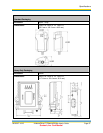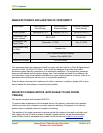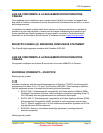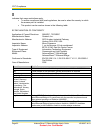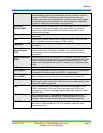
Glossary
Page 66 AirborneDirect™ Ethernet Bridge User's Guide 100-8007-141G
Quatech, Inc. Confidential
Disassociation
service
An IEEE 802.11 term that defines the process a station or Access Point uses
to notify that it is terminating an existing association.
Distribution service
An IEEE 802.11 station uses the distribution service to send MAC frames
across a distribution system.
GPIO
General Purpose Input/Output refers to the digital I/O lines.
Hot spot
Same as an Access Point (usually found in public areas such as coffee shops
and airports).
IEEE
Institute of Electrical and Electronic Engineers, an international organization
that develops standards for electrical technologies. The organization uses a
series of numbers, like the Dewey Decimal system in libraries, to differentiate
between the various technology families.
Independent Basic
Service Set Network
(IBSS Network)
An IEEE 802.11-based wireless network that has no backbone infrastructure
and consists of at least two wireless stations. This type of network is often
referred to as an “Ad-Hoc network” because it can be constructed quickly
without too much planning.
Infrastructure mode
A client setting providing connectivity to an Access Point. As compared to Ad-
Hoc mode, whereby PCs communicate directly with each other, clients set in
Infrastructure mode all pass data through a central Access Point. The Access
Point not only mediates wireless network traffic in the immediate
neighborhood, but also provides communication with the wired network. See
Ad-Hoc Mode and Access Point.
LAN application
A software application that runs on a computer (which is attached to a LAN,
Intranet or the Internet) and using various protocols, can communicate with
the Bridge.
LEAP
Lightweight Extensible Authentication Protocol developed by Cisco. LEAP
provides username/password-based authentication between a wireless client
and a RADIUS server. It is one of several protocols used with the IEEE
802.1X standard for LAN port access control.
Local Area Network
A system of connecting PCs and other devices within the same physical
proximity for sharing resources such as Internet connections, printers, files
and drives. When Wi-Fi is used to connect the devices, the system is known
as a wireless LAN or WLAN.
Medium Access
Control Layer
One of two sub-layers that make up the Data Link Layer of the OSI reference
model. The MAC layer is responsible for moving data packets to and from
one network node to another across a shared channel.
Peer-to-peer
network
A wireless or wired computer network that has no server or central hub or
router. All the networked PCs are equally able to act as a network server or
client, and each client computer can talk to all the other wireless computers
without having to go through an Access Point or hub. However, since there is
no central base station to monitor traffic or provide Internet access, the
various signals can collide with each other, reducing overall performance.




